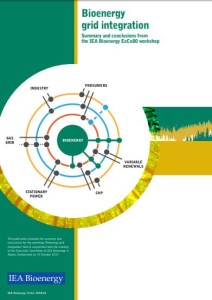 Last February IEA Bioenergy released a publication report providing the summary and conclusions from the workshop ‘Bioenergy grid integration’ held in conjunction with the meeting of the Executive Committee of IEA Bioenergy in Baden, Switzerland on 19 October 2017.
Last February IEA Bioenergy released a publication report providing the summary and conclusions from the workshop ‘Bioenergy grid integration’ held in conjunction with the meeting of the Executive Committee of IEA Bioenergy in Baden, Switzerland on 19 October 2017.
The use of grids is an efficient means of distributing various types of energy, including electricity, heat and gas. Connecting bioenergy to (existing) grid infrastructure facilitates short and long term deployment of bioenergy, and provides important opportunities for greening such grids. It also creates options for convergence and integration, which can help balancing grids and create synergies with other renewable energy forms.
The workshop demonstrated a number of cases and strategies of bioenergy grid integration and provided an opportunity to further discuss the role bioenergy could play in greening energy grids.
Key findings:
- Biomass can play an important role in the greening of heat provision through district heating networks. Existing district heating systems provide ideal platforms to transition from fossil to renewable and residual heat while new district heating systems have major challenges related to (capital) costs and governance.
- There are ways to optimise the use of heat grids, by following quality management guidelines (to limit energy losses), introducing heat storage in the system, and through demand side management. It is also important to incorporate flexibility so that various producers can be connected to the grid. Appropriate governance models (such as public-private partnerships) need to be developed, which are case and location specific, and also depend on regional policies and regulations.
- It is clear that synergies between different energy grids – particularly power, heat and gas – are increasing. Biogas is very well suited to demand responsive energy production. An effective approach to stabilise the power grid (with an increasing share of variable renewable energy) is to combine decentralised renewable energy production units in a ‘virtual power plant’, which is marketed and controlled through a central stakeholder.
- Providing flexibility to the power grid should be monetised through specific remunerations or bonuses. The concurrent provision of heat in CHP systems should be taken into account. Testing grounds need to be implemented for the control infrastructure of the future energy system, which will have higher levels of intermittent renewable energy sources. While renewable energy incentives have so far focused mostly on power production, this should be opened up to renewable heat and renewable gas provision.
- Biomethane and power-to gas concepts can improve the environmental footprint of gas used by various customers. Moreover, connecting biogas/biomethane to the gas grid provides a large buffer, providing the flexibility to use the gas for CHP, heat or as transport fuel. The renewable nature of this gas should be recognised in the gas grid (e.g. through guarantees of origin). New concepts and business cases for power-to-gas, capturing CO2 (particularly CO2 separated during the process of biomethane production) and converting it into additional biomethane through hydrogen from renewable power should be further explored, while also accounting for their role in balancing power grids.
The full summary and conclusions report from the IEA Bioenergy ExCo80 workshop can be downloaded here.
Further information: http://www.ieabioenergy.com


